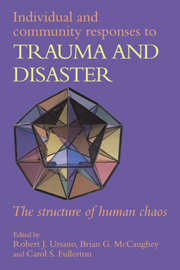Book contents
18 - The structure of human chaos
from Part V - Conclusions
Published online by Cambridge University Press: 13 October 2009
Summary
Even in the midst of the human chaos that results from traumatic events, the excellent contributors to this volume have identified elements of structure. The structure of trauma – predictable responses of individuals and communities – can be either helpful or harmful to health, family, and community. The complex web of human trauma is a challenge to clinicians, researchers, community leaders and, of course, the victims of trauma. Trauma and disasters come in many forms. The victims of these events are widespread and include not only those directly experiencing the disaster but, also, family, friends, disaster workers, and others who may be a part of the ‘community of meaning’ of the traumatic event. The structure described in the contributions to this volume brings us back to the basic questions addressed in the model presented in the opening chapter. What is the nature of trauma? Who are the victims of traumas and why are they at risk? How does the recovery environment affect outcome?
The stress of trauma
Trauma and disasters are primarily defined by their risk to life, however, this only begins the definition. It is the interaction of the nature of the stressor and its mediators that results in the individual's experience of traumatic stress (Table 18.1). Some groups are exposed to the threat of a traumatic event long before its occurrence. The anticipation of a trauma or a disaster is an infrequently looked at chronic stressor for some populations.
- Type
- Chapter
- Information
- Individual and Community Responses to Trauma and DisasterThe Structure of Human Chaos, pp. 403 - 410Publisher: Cambridge University PressPrint publication year: 1994
- 8
- Cited by



